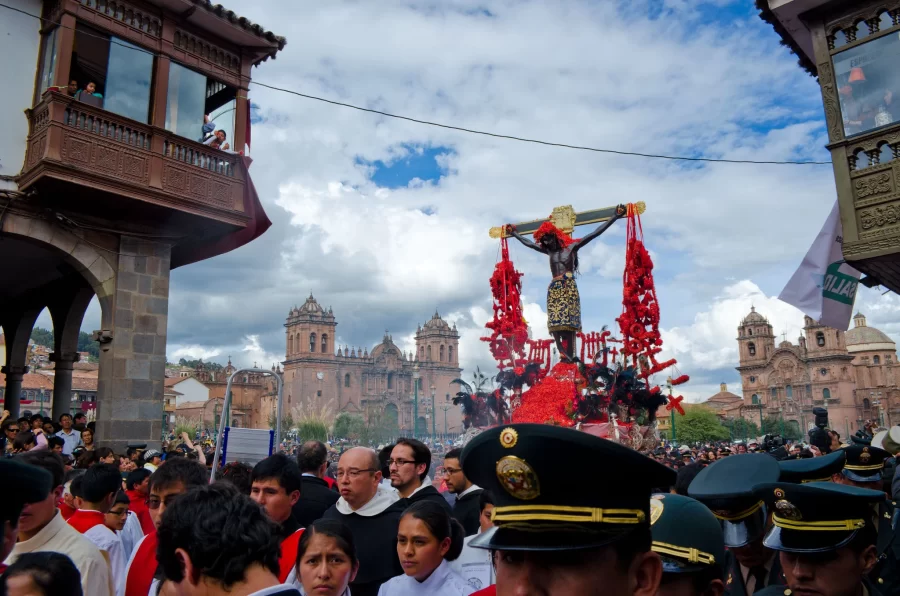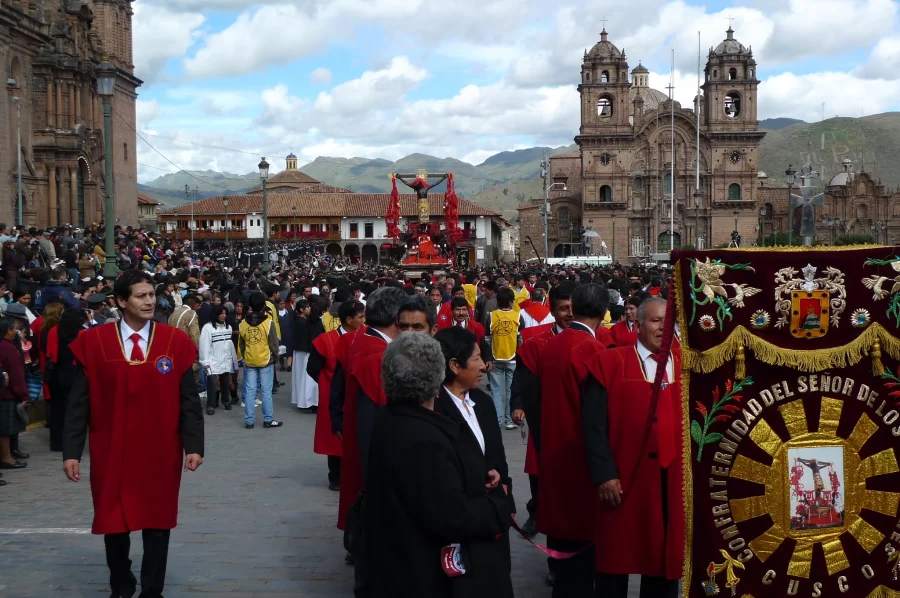
In Cusco many of its religious traditions are a sample of the cultural syncretism between European and Andean traditions. Thus, in Cusco there is the celebration of the Patron Saint of the city, the Lord of the Tremors, the image of a brown Christ, who annually goes out to the main streets of the city to bless the faithful and devotees.
Table of Contents
According to historians, on March 31, 1650, an earthquake of great magnitude occurred in the city of Cusco, whose duration, according to the oil painting of the cathedral of Cusco, was 3 consecutive creeds, and according to the chronicle of Fray Diego de Cordova ''… was so terrible, that in a brief space of a quarter of an hour, it destroyed the best buildings of that most noble city, its houses, convents and sumptuously built churches''.
In the midst of such a disaster the inhabitants of Cusco took to the streets, between cries and prayers they asked God to calm his anger and stop such punishment, it was then that the image of the Crucified Christ was taken from the cathedral to the streets of Cusco. Being miracle or consequence that the aftershocks of that earthquake lowered intensity to stop, it is so since then the Christ would adopt the name of ''The Lord of the tremors''.
It was thus established that every March 31st the Christ would go out in procession annually and so it was done until decades later it was established that the Christ would start the celebration of Holy Week, leaving the cathedral every Holy Monday giving a tour through the main streets of the city and filling the faithful devotees and all attendees with his blessing.
The history of this Christ is found in a canvas of the year 1650, whose author is anonymous, but it is known that it was painted by order of Alonso Monroy y Cortés, this painting is the only pictorial evidence that we have of that disaster; currently this painting is in the cathedral of Cusco which you can visit from 10 am to 17 pm (tourist visits schedule).


For the departure of the Señor de los Temblores a series of activities are carried out:
First, they pick a flower that grows in the Andes and blooms only on this festive date, the Ñupchu, they pick them carefully in baskets and carry them for the procession, they attack them and others throw them at the Lord and it reaches his head, it is like this throughout the blessing.
Second, there is also a group of women called the cantoras or Ch'ayñas, who participate in a group of chants sung by themselves and were declared Cultural Heritage of the Nation in 2014.
The songs are in Quechua and the most traditional are Apu Yaya Jesus Christ (Father Lord Jesus Christ), Qanmi Dios Kanki (You are God) and Qollana Maria (Mary the First).
Finally, the procession takes place through the various main arteries of the imperial city of Cusco, before the Lord of the Tremors made only one blessing and everyone was concentrated in the Plaza de Armas to wait for the blessing, this was at about 8 pm.
However, now the Taytacha de los Temblores makes two blessings in different points of the city, the first blessing is made in the San Francisco square and then he rests in the church of La Merced. After that he goes to the Plaza de Armas to give his main blessing to the four cardinal points to a great multitude of people who have been waiting for him since early in the morning.
During the blessing many people ask, thank, shed tears and throw petals of ñupchu to the Patron Saint of Cusco.
Faced with all the events suffered by the city of Cusco, the population decided to take out the Lord of the Earthquakes who calmed all the calamities, from there they decided to take him out in procession every year, at first went in procession on March 31.
However, since 1741 this image would go out every Holy Monday giving beginning to the Holy Week, and in 1928 receives another date to pay homage to him and this time will go out the last Sunday of October, day recognized by the Catholic Church as the feast of Christ the King.
Currently, the date is movable, but it is fixed that it leaves in procession on Holy Monday, giving beginning to the celebrations of the Holy Week in Cusco during the first weeks of April.
During the year 1650 after March 31st there are records of up to 226 tremors in the city of Cusco that occurred throughout the year being a fairly high amount even considering that the city of Cusco is located in a seismic area.
Thus, during the strong movement of March 31, the brown Christ was taken to the streets, calming the seismic movement. Because of this miracle, the Christ, whose name was formerly ''Señor de la Buena Muerte'' changed to ''El Señor de los Temblores''.
Years later, during the plague that devastated the city of Cusco in 1720 the image was taken in procession calming and healing the sick, so that year would also be declared ''Patron Jury of Cusco''.
The Lord of the Tremors begins his journey starting at the Plaza de Armas, once he leaves the Cathedral Basilica, continuing his journey through the streets.
Returning to the Plaza de Armas, he is received by the entire population of Cusco and amidst the sound of the Pututus and sirens of the Fire Department, the Taytacha de Los Temblores gives his blessing to the people of Cusco, returning to the Cathedral where he remains until the following year.